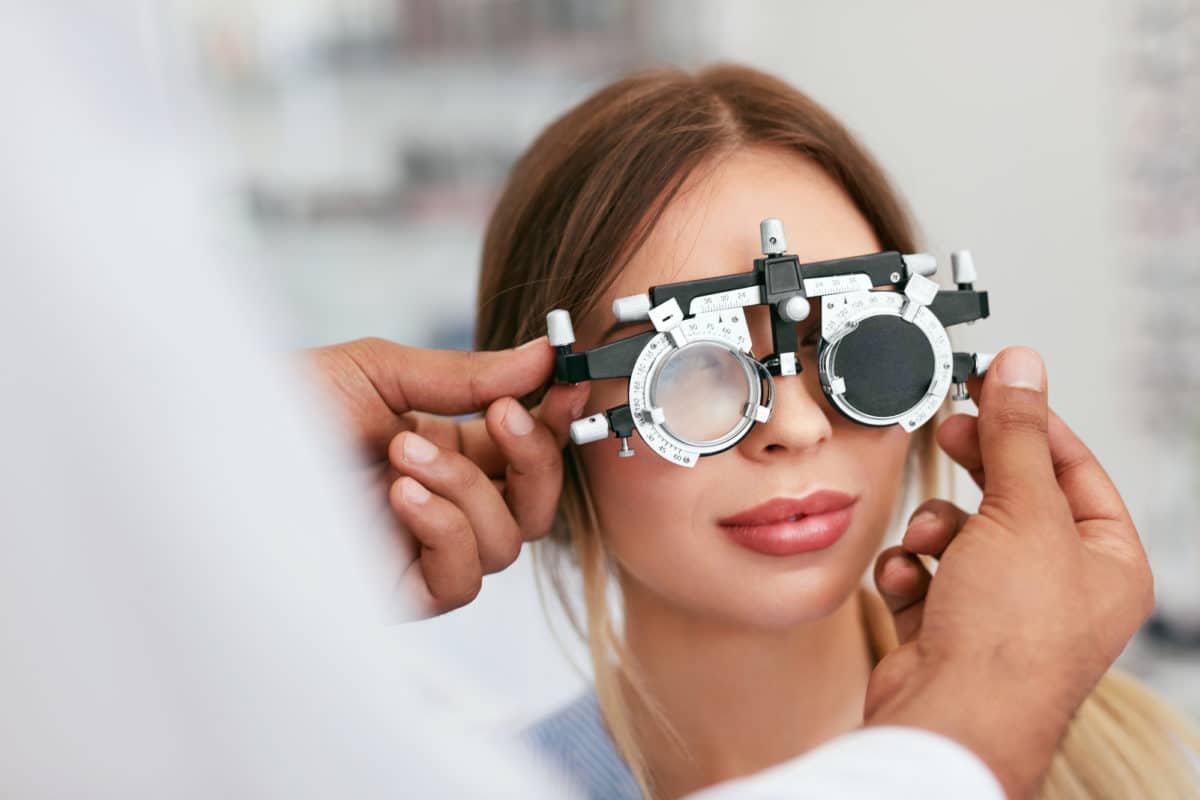What Are Vision Impairments?
Simply put: Many of us take our sight for granted. We rarely think about how intricate the human eye and corresponding systems are or how objects in front of us become an image in our brain. However, for those who are visually impaired, dysfunctions, problems, and diseases that impact these systems affect their everyday life.

So, what is a vision impairment? What are types of vision impairments? How does a vision impairment compare to vision loss? In this article, we’re going to cover it all.
What is a Vision Impairment?
Being visually impaired means an individual suffers any type of vision loss. This includes individuals who have legally blind vision, as well as partially sighted individuals. In fact, individuals who use glasses or contact lenses have a visual impairment. Unfortunately, when one or both eyes become damaged or experience disease, a range of vision loss and impairments may occur.
The human eye, technically, is the camera for your brain. The eye creates an image on a structure known as the retina, which then translates this light into nerve impulses. These nerve impulses travel to your brain, which creates an image in your mind. When you think about it, this whole process is pretty spectacular!
However, with age and other factors, we can quickly lose this important sense, which may make maintaining your independence and performing daily tasks that much harder.
Who Does It Affect?
According to the World Health Organization, about 2.2 billion people globally experience a near or distance vision impairment. About 50% of these individuals have a condition that could’ve been prevented. At the same time, the majority of these individuals are over the age of 50, indicating the undeniable link that age plays in visual impairments. So, what exactly can impact whether someone ends up as visually impaired or not?
Age
As time goes on, the human body becomes less effective and restoration and repair. Inevitably, this can lead to a decline in vision, eventually causing someone to become visually impaired. About one in three individuals 65 years and older experience some kind of vision loss. Some of the most common age-related visual impairments include macular degeneration, cataracts, glaucoma, and diabetic retinopathy.
Heredity
If your parents have a visual impairment, it’s much more likely you will as well. Surprisingly 60% of infant blindness is due to hereditary factors and diseases.
Emotional Factors
Research shows that increased stress can have a negative impact on an individual’s eyesight. In fact, it can turn into a vicious cycle where a person’s vision loss can result in increased stress, yet this increased stress may result in increased vision loss. This can lead to a downward spiral and, inevitably, a lower quality of life.
Social & Economic Factors
The World Health Organization indicates that low and middle-income individuals have a four times higher chance of experiencing a visual impairment when compared to higher-income individuals, suggesting a link between visual impairments and economic and social factors. It’s further estimated that about 80% of individuals in sub-Sahara African regions experience visual impairments when compared to only 10% of individuals in high-income countries.
Types of Visual Impairments
There are many conditions and diseases that can lead individuals to become visually impaired. Some types of low vision-related conditions include the following.
Macular Degeneration
Macular degeneration happens due to a slow and gradual deterioration of the macula. The macula is part of the retina, helping create a sharp and clear image. As this disease progresses, it becomes more and more difficult to see fine details, particularly in the front part of one’s visual field.
While often age-related, with most incidences occurring in those 60 years and older, it can also occur in younger individuals. In fact, smoking and excessive sunlight exposure can quickly lead to this eye impairment. Some common signs of macular degeneration include difficulty watching TV or reading a book, as well as the appearance of objects appearing smaller or larger than they should.
Retinitis Pigmentosa
Retinitis Pigmentosa (RP) is a genetic condition that impacts the retina and its ability to respond correctly to light. This impairment may result in night blindness, lack of peripheral vision, and problems with color vision. Many people with this disease gradually lose their eyesight, requiring increased illumination and experiencing increased visual fatigue as it declines.
Stargardt's
This is another genetic condition leading to an individual becoming visually impaired. Stargardt’s occurs when fatty substances accumulate on the macula, which gradually reduces vision and the ability to make out details. This type of visual impairment can happen gradually or quickly, depending on the individual.
Usually, it involves hazy spots in the center of one’s visual field, light sensitivity, and color blindness.
Glaucoma
Glaucoma occurs when there is increased intraocular pressure in the eye. This typically leads to optic nerve damage. Usually, this condition happens with age. However, babies can be born with it, and adolescents and adults can also develop it.
A person with glaucoma may also require increased illumination to see properly, along with glare control, as well as large print materials to accommodate for peripheral vision loss. Individuals that develop glaucoma also may find their physical activities restricted.
What Are the Levels of Vision?
You’ve likely heard of “20/20 vision” but what exactly does this mean? If you’ve been to the eye doctor’s office, you’ve likely undergone a vision test where you recited the letters on a poster far away. The letters on the poster typically get smaller from the top to the bottom. Each level is rated accordingly. This “poster” is known as the “Snellen eye chart.”
This eye chart measures visual acuity. Within a certain area and when read about 20 feet away, an individual with 20/20 vision should be able to make out each letter. If an individual can only make out the letters two rows above that line, they likely need two times magnification. Inevitably, an individual who is visually impaired won’t be able to make out the letters within the 20/20 vision area, leading their optometrist to find other solutions, such as glasses and other assistive devices.
Assistive Devices for Visually Impaired
Luckily, for individuals who are visually impaired, technology has come a long way! The type of visually impaired product you choose may depend on the type of visual impairment you have. However, the following sections provide a brief overview of the innovative visually impaired products that have emerged over the last few decades, helping individuals with visual impairments see more clearly once again.
Low Vision Glasses
Glasses have been around for a while. It’s thought glasses were originally invented all the way back in the 1200s. While the exact date is up for dispute, reading glasses offer many visually impaired individuals the opportunity to read their favorite books or news articles. At the same time, these glasses may mean you need to hold objects closer to your face, which may pose some difficulties over time.
Glare-Control Devices
As previously mentioned above, glare can become particularly problematic for those with a visual impairment, especially those with cataracts. Similar to regular glasses, glare-control devices have an additional piece that acts as a hat or hood over a tinted lens. This reduces glare, helping individuals have increased vision clarity.
Magnifiers
From classic magnifiers to electronic magnifiers, these devices can help visually impaired individuals read text. For instance, a desk magnifier sits over the top of the text, allowing a person to read the text in larger print. A CCTV reader, on the other hand, magnifies images via the use of a camera and video monitor or computer screen.
Phone Applications & Software
Certain phone apps can help magnify currency and specific objects. Meanwhile, dictation software offers virtually impaired individuals a new way to research, text, and read. Some types of dictation software even have the capability to transform written text to Braille.
Electronic Glasses
For those with severe visual impairments, a low vision specialist may direct you toward exploring electronic glasses. These types of products for visually impaired seniors and other adults can help you lead a relatively normal life, all thanks to innovative technology!

Vision Buddy is a breakthrough assistive device that is the first TV watching wearable for low vision users. These smart glasses for the visually impaired allow individuals to see their loved ones, watch TV, play video games, read, enjoy hobbies, and more. In many ways, these types of devices, such as the Vision Buddy, can help individuals regain their independence.
Frequently Asked Questions (FAQs)
Still got a few questions? We’ve taken the time to list frequently asked questions and answer below, helping address any concerns or inquiries you might have.
What causes visual impairment?
According to the World Health Organization (WHO), the leading causes of visual impairments include cataracts and uncorrected refractive errors (conditions that can easily be corrected via the use of prescription glasses). At the end of the day, visual impairments happen due to all kinds of reasons, such as age, genetics, social factors, economic factors, injury, trauma, and more.
What are the signs of visual impairment?
Signs of visual impairment usually involve not being able to see objects clearly from far distances (or right in front of you). For instance, some individuals may find themselves holding a book closer to their face than they previously would. Other signs include struggling to focus, headaches, frequent squinting, rubbing of the eyes, sensitivity to light, and bumping into objects.
How is visual impairment diagnosed?
The Snellen eye chart is frequently used to assess vision and vision loss. It can help diagnose certain visual impairments. Other testing may include visual field tests and tonometry tests (which measure the pressure in the eye).
What are the challenges of visual impairment?
Visually impaired individuals face tons of challenges on a daily basis. These may include:
- Navigating where to go.
- Societal stigma.
- Lack of support.
- Struggling to perform daily tasks, such as laundry.
- Difficulty finding employment.
- Enjoying previous hobbies or activities.
- Isolation.
Yet, selecting the right visual impairment device can help some individuals overcome some of these struggles. Some devices can even help a person gain back their independence and find enjoyment in performing activities or hobbies they previously found joy in.
How does visual impairment affect a person?
A visually impaired individual may experience a decline in their quality of life, reduced mental health, and an increased risk of falls. Vision loss has been associated with increased loneliness, anxiety, worry, fear, and social isolation. In fact, unfortunately, depression is a common occurrence in those who are visually impaired.

